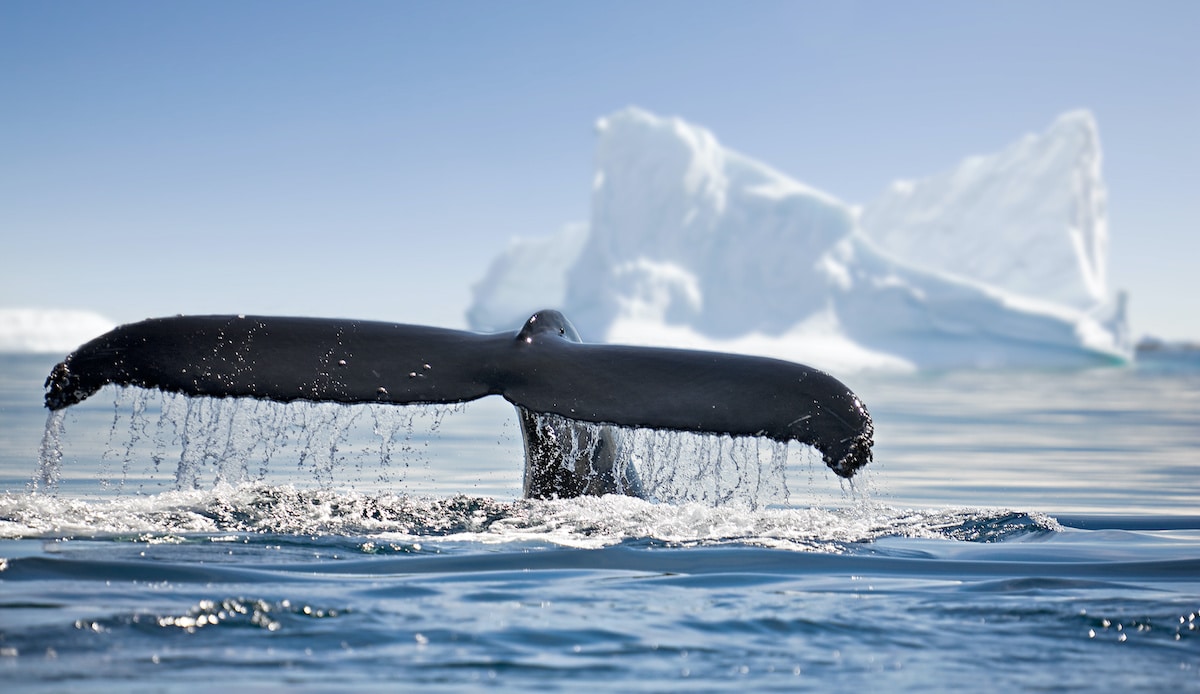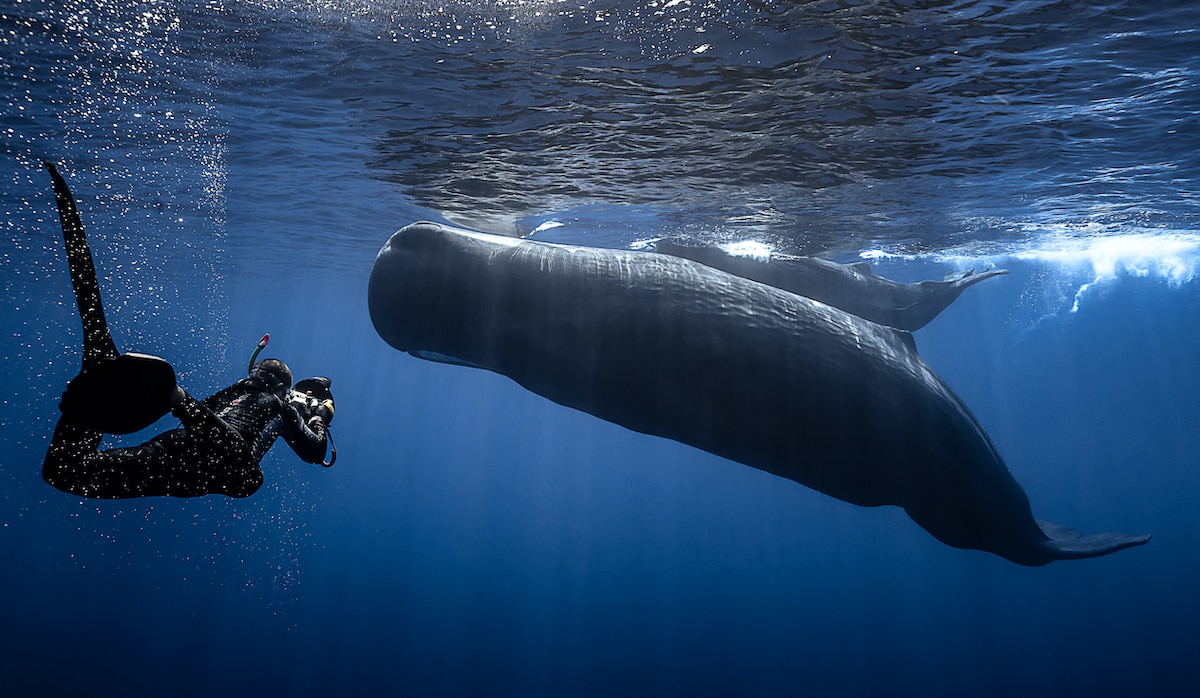News
9 epic dive destinations for whale fans

Whether you’re swimming with whales or watching them from a boat, there is something truly special about spending time with these ocean giants.
Thankfully there are a variety of dive destinations that offer whale swimming and above-water whale encounters you won’t want to miss.
Read our guide to the best dive destinations for whale fans to find out more.
1. Great Barrier Reef, Australia
For one of the lesser known yet incredible whale experiences, go Great Barrier Reef diving during the Australian winter.
Tens of thousands of whales migrate from Antarctica to the Great Barrier Reef during the winter months, including dwarf minke whales.
These 8 meter long whales are utterly charming and actively seek human contact, coming close to snorkelers in the water and making repeated passes.

Photo: Ocean Quest liveaboard
You can see them whilst scuba diving but joining a minke whale safari is the best way to spend hours in the water with these whales.
The Ocean Quest liveaboard offers ‘meet the minke’ safaris during July each year.
2. Norway
The largest member of the dolphin family and toothed whales, orcas are easy to identify and a firm favourite with ocean fans around the world.
Hundreds of orcas gather off the coast of northern Norway during the Arctic winter to feast on migrating herring moving through the fjords and along the coastline.
Since they follow the herring, the orcas are relatively easy to find. You can join dedicated safaris with the Sula liveaboard to get in the water with the orcas as a snorkeler or free diver.
Just be prepared for typically cold Arctic winter conditions and chilly water!
You’ll be rewarded with a life-changing experience and a great chance of seeing the Northern Lights dance across the night skies.
3. Tonga
Tonga has some beautiful dive sites without any crowds but is best known for its clear blue waters and abundant humpback whales.

It is one of the best and most reliable places in the world to swim with humpback whales and their young. It’s also an idyllic destination for a far-flung adventure any time of year.
The Nai’i liveaboard is one of the few boats that offer liveaboard-based Tonga humpback whale swim safaris.
Just make sure you book early, as it’s extremely popular.
4. Dominican Republic
Silver Bank marine reserve in Dominican Republic is another great place for swimming with humpback whales.
The marine reserve provides a winter haven for the North Atlantic humpback population, where they gather to mate, calve and raise their young.
The Turks and Caicos Aggressor II offers safaris that focus solely on humpback whale swimming, typically from January to March each year.
5. Spitsbergen
If you’re visiting the Arctic during the summer months, you won’t be able to dive with orcas but you can go diving around Spitsbergen off Norway.
It’s a remote and wild destination where you can try ice diving, boat-based diving and even wreck diving.
The best dive sites are only accessible by Arctic liveaboard diving and you’ll find plenty of life underwater, including sea snails, sea butterflies, crabs, fish, sea lions and more.
While you’re there you can spot minke, fin, humpback and blue whales, plus walruses, Arctic foxes, bearded seals and an array of birds.
6. Hawaii
The Hawaiian chain of volcanic islands offers a good mixture of dive options, including wrecks, caves, healthy reefs and drift dives.
All accompanied by lush coral gardens and striking lava landscapes, plus marine life you won’t find anywhere else on Earth.
If you dive there during November to May, you also have the chance to watch Hawaii’s humpback whales as they migrate through the area.
Keep your eyes on the blue if you’re diving off Oahu during September to December, as that’s also tiger shark season.
7. Ningaloo Reef, Western Australia
If you’ve not yet dived Western Australia, add it to your wish list.
Quieter than the Great Barrier Reef, western Australia offers an array of dive opportunities and plenty of marine megafauna.
The UNESCO-listed Ningaloo Coast supports an abundance of marine life including humpback whales from July to November.

Thousands of these whales migrate through Ningaloo Reef each year, where you can go swimming with them or enjoy their mating displays from the comfort of your boat.
8. Mexico
The Cabo Pulmo marine park, the Socorro Islands and the Sea of Cortez all offer spectacular Mexico scuba diving and whale watching.
These megafauna hotspots offer encounters with many whale species; including blue whales, grey whales and humpbacks, plus giant mantas, dolphins and sea lions.
If you’re looking to encounter blue whales, head to Baja California between February and March.
For grey whales, visit from January to mid-March. The Socorro Islands host humpback whales during the winter season until April.
9. Antarctica
For a truly remote adventure and whale watching experience, join an Antarctic liveaboard diving expedition.

As one of the world’s last wilderness areas, it is busy with life including around 15 whale species.
Go diving there and you have a chance to dive Antarctica and immerse yourself in snow and ice-covered landscapes.
You may also see blue, fin, humpback, minke, sei, southern right and sperm whales during your expedition.
 This article was written by divers and writers at LiveAboard.com
This article was written by divers and writers at LiveAboard.com
Gear News
Introducing the TR-80, IR-50 and CS-30 Regulators from DYNAMICNORD

Whether you are a beginner or a professional diver – with the three new main regulators from DYNAMICNORD, everyone will find their favourite regulator. They all look super stylish.
Excellent performance with the TR-80
Quality and performance are the be-all and end-all for regulators. It is not for nothing that the TR stands for Tec Reg. The innovative design of the TR-80 guarantees absolute reliability – even in ice-cold waters.

Perfect breathing effort at 0.8 J/l / certified for diving in waters below 10 degrees / structural design made of solid brass for best cold protection / membrane-compensated design with dry seal of the first stage / reduced exhalation effort thanks to optimized exhalation membrane and bubble deflector / adjustable Venturi (dive/predive) and adjustment knob for individual inhalation comfort / innovative design of the front cover prevents free-flow in strong currents or when diving with scooters / design made of sandblasted brass, matt chrome finish / 2 HP and 4 LP outlets / mouthpiece made of high-quality, anti-allergic silicone for maximum comfort.


Amazing underwater adventures with the IR-50
The IR-50 is the top regulator for advanced and experienced divers. Natural breathing is the essence of this regulator.

Ideal breathing effort at 0.8 J/l /certified for diving in waters below 10 degrees / compensated membrane / adjustable venturi (dive/predive) and adjustment knob for individual inhalation comfort/ outlet valve and deflector for minimum exhalation effort and reduction of bubbles on the face / design made of sandblasted brass, matt chrome finish / 2 HP and 4 NP outlets / mouthpiece made of high-quality, anti-allergic silicone for maximum comfort.


The Workhorse – our CS-30
For diving centres and diving beginners – the workhorse stands for strong construction, reliability and robustness. Perfect for your training.

Optimal breathing effort at 0.8 J/l /recommended for diving in waters above 10 degrees / non-compensated piston / adjustable venturi (dive/predive) / outlet valve and deflector for minimum exhalation effort and reduction of bubbles on the face / design made of sandblasted brass, matt chrome finish / 1 HP and 3 NP outlets / mouthpiece made of high-quality, anti-allergic silicone for maximum comfort.


Octopus OP-30
The OP-30 is the ideal addition to all DYNAMICNORD regulators. It is identical in construction to the CS-30.

The TR-80, IR-50, CS-30 (DIN & INT) regulators and the Octopus OP-30 are available from DYNAMICNORD dealers and in the online store.
DYNAMICNORD – Your Outdoor Companion.
Marine Life & Conservation
Paul Watson Released as Denmark Blocks Japan’s Extradition Bid

Renowned anti-whaling activist Paul Watson has been released from custody in Greenland after spending five months in detention. Denmark’s Justice Ministry rejected Japan’s request for his extradition, citing insufficient guarantees that his time already served in custody would be credited against any potential sentence.
The 74-year-old Canadian-American was arrested on July 21 in Nuuk, Greenland’s capital, when his ship docked to refuel. His arrest was based on a 2012 Japanese warrant related to a 2010 encounter in Antarctic waters. Japan alleged Watson obstructed operations and caused damage to a whaling research ship during efforts to disrupt illegal whaling. Watson has consistently denied these claims, maintaining his commitment to marine conservation.
Denmark, which oversees extradition matters for Greenland, concluded that while the legal conditions for extradition were met, the lack of assurances from Japan regarding time-served credit made extradition untenable.
In a video shared by his foundation, Watson expressed gratitude and relief, saying, “After five months, it’s good to be out… and good to know they’re not sending me to Japan.” He added that the most difficult part of his time in custody was being separated from his two young sons.
Watson is a pioneering figure in marine conservation, known for founding the Captain Paul Watson Foundation in 2022 after decades of activism with the Sea Shepherd Conservation Society. His bold efforts to defend marine life have earned him widespread support, including from celebrities and conservationists. His work has also been featured in the acclaimed reality TV series Whale Wars.
Watson’s lawyer, Jonas Christoffersen, praised the decision, stating, “We are happy and relieved that Paul Watson is now free.” He added that Watson is eager to reunite with his family and continue his vital work.
The arrest occurred while Watson’s vessel, the M/Y John Paul DeJoria, was en route to the North Pacific with a team of 26 volunteers to intercept a Japanese whaling ship. His foundation described the arrest as politically motivated and emphasized that Watson’s actions were focused on ending illegal whaling practices.
Japan resumed commercial whaling in 2019 after leaving the International Whaling Commission, asserting that whale meat is a cultural tradition. Conservationists, however, continue to challenge these practices, highlighting their impact on marine ecosystems.
Despite the challenges, Watson remains steadfast in his mission to protect marine life and bring attention to whaling practices. His dedication to ocean conservation has made him a globally respected advocate for the environment.
-

 News2 months ago
News2 months agoIconic SS United States to become the World’s Largest Artificial Reef
-

 News3 months ago
News3 months agoBook Review – 52 Assignments: Underwater Photography
-

 Gear News3 months ago
Gear News3 months agoDYNAMICNORD – New German diving brand enters the British market
-

 News3 months ago
News3 months agoExploring Cenote El Pit: A Diver’s Dream
-

 Gear News3 months ago
Gear News3 months agoTry BARE drysuits (and maybe even win one!) this Friday with Sea & Sea at North West Dive Fest
-

 Marine Life & Conservation3 months ago
Marine Life & Conservation3 months agoBook Review: Coral Triangle Cameos
-

 Blogs2 months ago
Blogs2 months agoDive the Egyptian Red Sea this Autumn with Regaldive
-

 News3 months ago
News3 months ago2024 Ocean Art Underwater Photo Competition Announced















